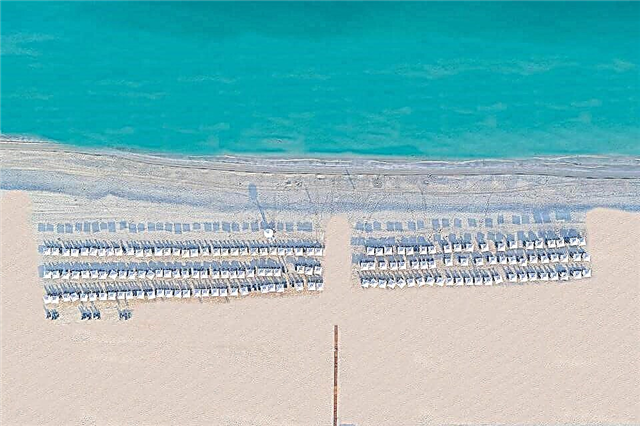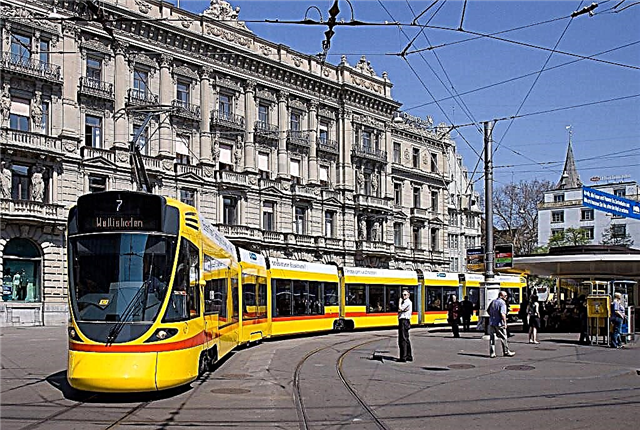Address: Russia, Nizhny Novgorod region, Nizhny Novgorod, Oksky congress street, 2
Based: in 1370
Main attractions: Holy Cross Cathedral
Shrines: Cross-crucifix carried along the Way of the Cross of the Savior in Jerusalem, a cross with a particle of the tree of the Life-giving Cross of the Lord, an Ark with particles of the relics of the Kiev Caves saints
Coordinates: 56 ° 18′25.85 ″ N 43 ° 58′54.5 ″ E
Content:
The convent dedicated to the Exaltation of the Holy Cross stands on a high place in the old part of Nizhny Novgorod. It keeps the history of female monasticism of the three monasteries that existed in the city - the Conception, Resurrection and Proishozhdensky monasteries. The Monastery of the Exaltation of the Cross went through difficult periods of reorganization, it was closed for several decades, but today it is actively reviving.

View of the monastery gate
History of the monastery
The first monastic cloister appeared in the city in the XIV century (between 1355 and 1365). It was built on the Volga bank, near the mouth of the river. Pochayna, at the foot of the Kremlin. It is known that this monastery was founded by the wife of Prince of Nizhny Novgorod Andrei Konstantinovich - Princess Anastasia on a vow, as a request to God to send children. However, for 12 years of marriage, the princess was never destined to know the joys of motherhood. After the death of her husband, Anastasia lived in the world for another four years, and then took monastic tonsure, distributed her wealth to the temples, dismissed the servants and began to live in the monastery she created under the name of Theodora. The nun died in 1378 at the age of 47. The Orthodox Church celebrates the Day of Remembrance of St. Theodora on April 29.
The Conception Monastery prospered for a long time, and its chopped Pokrovsky Church (1621) was considered one of the richest churches in Nizhny Novgorod for decoration. But due to the fact that the monastery was completely wooden, it often suffered during fires. In addition, the foundations of buildings were constantly destroyed by the springs that gushed in this place.
The monastic buildings were especially severely lost in the late 17th and early 18th centuries. In 1743, the monastery burned down to the ground, and the bishop ordered to allocate land next to the St. George Tower of the Nizhny Novgorod Kremlin so that the nuns could start managing at their own discretion. The new monastery on the tower began to be called St. George's, and wooden cells were built for the nuns. Nearby there was another women's monastery dedicated to the Origin of the Honorable Trees of the Cross of the Lord, which was created in 1612. In 1716, a new Church of the Exaltation of the Holy Cross was erected here, and the Origin monastery took the name of this temple.
Another women's monastery of the city - Voskresenskaya was originally located in the Kremlin itself, near the Nikolsky Gate. Exact information about the time of its foundation has not been preserved, but for the first time this monastery is mentioned in documents from 1621. The Resurrection monastery also suffered greatly from the fires, and in 1723 several nuns collected the surviving property and moved to the Holy Cross Monastery.

Holy Cross Cathedral
In 1764, a church reform took place in Russia, and all three monasteries merged into a single monastery - Holy Cross. Years passed, and in 1812, by a special state decree, this monastery was allocated a new territory on the then deserted city outskirts, not far from the Kazan cemetery and the church of the same name. The dismantled monastery church and some buildings were transported there. By the fall of 1814, the new territory of the monastery was surrounded by walls, and eight stone buildings for the nuns, a bell tower, and a hospital church were erected on it, and the foundation of the future monastery cathedral was laid.
However, the expenses for the arrangement of the monastery were so great that the cathedral was completed only by 1823. The five-domed Holy Cross Church outwardly looked like a cross and was very reminiscent of the St. Petersburg Kazan Cathedral. Two side-chapels were made in it, dedicated to the Praise of the Most Holy Theotokos and St. Innocent of Irkutsk.
In the 20-30s of the XIX century, the monastery looked great. Its territory was surrounded by a regular quadrangular fence with small corner towers. The belfry rose 34 m high above all the buildings, where there were seven bells of different sizes. In 1838, a school was opened here for girls orphans, who lived in the monastery on full support. They were taught to read, write and the basics of counting, and were also trained as embroiderers and embroiderers in satin stitch on canvas.
In addition to church duties, prayers and divine services, the sisters were busy making vestments for icons, sewing priestly vestments, air, shroud and garments for thrones. Works of amazing quality from the Nizhny Novgorod convent spread throughout Russia. They could be seen in the Astrakhan temples in the North, in the Transcaucasus and in Siberia. The icons embroidered with gold and silver threads were donated by the abbess of the monastery to the Russian Emperor Nicholas I himself.

View of the south-western facade of the Holy Cross Cathedral and the monastery belfry
In 1848, the monastery cathedral was thoroughly rebuilt, and the territory was significantly expanded and surrounded by a new high stone wall, inside which a large shady garden was laid out. Nizhny Novgorod, meanwhile, was upset and more and more approached the monastic monastery. The monastery, on the other hand, lived an ordinary charter life. He enjoyed a good reputation, and often his nuns were appointed as abbess to some nunnery in the Nizhny Novgorod province, or to other Russian provinces - in Arkhangelsk, Yaroslavl, Kostroma, Perm or Kazan.
After the revolution of 1917, when the Church was separated from the state by decree of the new government, the fate of the monastery changed dramatically. In the spring of 1918, a detachment of Red Guards arrived here, who wanted to requisition all the church property. Abbess Maria did not give them the keys to the storerooms and buildings, and the Red Guards began shooting at the crowd of nuns and pilgrims and killed two people. After a short time, the monastery was closed, setting up a concentration camp in its buildings, where former nobles, representatives of the intelligentsia, arrested officers and clergy were kept. And the monastic community began to be called "labor artel".
In 1927, a military town was placed in the former monastery, and the nuns were finally evicted. At first, they went to live in the nearby Kazan Church, but after a few years it was also closed, giving the premises for housing for Nizhny Novgorod residents. During the time of N.S. Khrushchev, the old Kazan temple was demolished, barbarously destroying the adjacent necropolis.
In the 1950s, the monastery's territory, which had miraculously survived, was partially built up, in addition, there was a sports ground. Those buildings that have survived were in turn occupied by city institutions. The last tenant in the former monastery was the plant. Sverdlov, who used the buildings of the temples for electroplating and waste disposal.

View of the main entrance of the Holy Cross Cathedral
In 1995, the Orthodox community received back the cathedral and two buildings, and the parishioners began to restore the ancient monastery. Four years later, the first divine services could be held in the cathedral. During the winter months, this temple was not yet heated, and believers could gather here only on Sundays and holidays.
In 2004, the parish was transformed into a nunnery, thereby restoring the centuries-old tradition of female monastic asceticism in the Nizhny Novgorod land. And since 2007, a procession with the icon of the Oran Mother of God has been held here again.
Current state and visiting regime
In our time, the convent is an active Orthodox monastery. Church services are held here daily at 8.00 and 17.00.The patronal feast in the monastery is celebrated on September 27. A Sunday school has been set up for the children of the parishioners at the monastery, and a medical center has been opened to help lay people, nuns and clergy.
Particularly revered shrines of this monastery are considered the ark with particles of the relics of Christian saints, the icon of the Kazan and Iberian Mother of God, as well as a cross with a particle of the tree of the Life-giving Cross of the Lord.
The monastic farmsteads are located in the Epiphany Church (the village of Epiphany, Delnekonstantinovsky District), as well as in the Church-Chapel "Life-Giving Spring" in the village of Kozlovka.
How to get to the monastery
The monastery is located in the Nizhny Novgorod region, on Oksky congress street, 2.
By car. On the Moskovskoe highway, you need to move the Metro bridge to Barminskaya street. Then, at the second traffic light, turn left - onto Krupskaya Street, drive straight along it and turn right onto ul. Ilyinskaya, which will lead to the territory of the monastery.

Monastery belfry
By public transport. The monastery can be reached by tram (stops "Krasnoselskaya st." And "Malaya Yamskaya st."), As well as buses and minibuses (stops "Oksky exit" and "Ploschad Lyadova"). It is easy to walk from the Gorkovskaya metro station to the monastery in 15 minutes (about 1 km).











